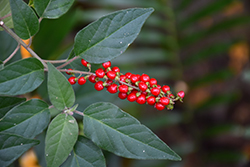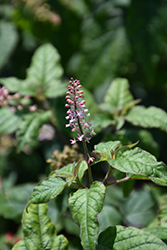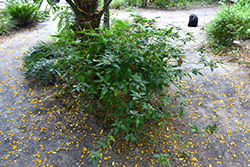It's all about ...
plants

Height: 5 feet
Spread: 3 feet
Sunlight:
![]()
![]()
Hardiness Zone: 8a
Other Names: Pigeonberry, Rouge Plant, Coral Berry
Description:
A shade loving, long lived evergreen sub-shrub, noted for its attractive fruit and flowers; tiny white to pink flowers bloom nearly year round, followed by clusters of scarlet berries; great for low light areas; hardy, drought tolerant, low maintenance
Ornamental Features
Bloodberry is primarily grown for its highly ornamental fruit. It features an abundance of magnificent scarlet berries from early winter to late fall. It features tiny panicles of white flowers with pink overtones at the ends of the branches from early winter to late fall. It has forest green evergreen foliage. The pointy leaves remain forest green throughout the winter.
Landscape Attributes
Bloodberry is a multi-stemmed evergreen shrub with an upright spreading habit of growth. Its relatively fine texture sets it apart from other landscape plants with less refined foliage.
This shrub will require occasional maintenance and upkeep, and can be pruned at anytime. It is a good choice for attracting birds and bees to your yard. Gardeners should be aware of the following characteristic(s) that may warrant special consideration;
- Self-Seeding
Bloodberry is recommended for the following landscape applications;
- Mass Planting
- General Garden Use
- Groundcover
- Naturalizing And Woodland Gardens
Planting & Growing
Bloodberry will grow to be about 5 feet tall at maturity, with a spread of 3 feet. It has a low canopy, and is suitable for planting under power lines. It grows at a fast rate, and under ideal conditions can be expected to live for approximately 10 years. This is a self-pollinating variety, so it doesn't require a second plant nearby to set fruit.
This shrub does best in partial shade to shade. It is very adaptable to both dry and moist growing conditions, but will not tolerate any standing water. It is considered to be drought-tolerant, and thus makes an ideal choice for xeriscaping or the moisture-conserving landscape. This plant should not require much in the way of fertilizing once established, although it may appreciate a shot of general-purpose fertilizer from time to time early in the growing season. It is not particular as to soil type or pH. It is quite intolerant of urban pollution, therefore inner city or urban streetside plantings are best avoided. This species is native to parts of North America..
This plant is not reliably hardy in our region, and certain restrictions may apply; contact the store for more information.


